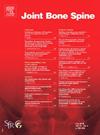Quantitative HRCT as a surrogate outcome measure for nintedanib treatment in systemic sclerosis-interstitial lung disease and idiopathic pulmonary fibrosis
IF 3.8
3区 医学
Q1 RHEUMATOLOGY
引用次数: 0
Abstract
Objective
We assessed the effect of nintedanib (NIN) in terms of quantitative HRCT changes in both idiopathic pulmonary fibrosis (IPF) and systemic sclerosis-associated progressive interstitial lung disease (SSc-ILD), evaluating the relationships between imaging variations and clinical-functional outcomes.
Methods
We prospectively enrolled SSc-ILD and IPF patients treated with NIN and retrospectively selected the same number of subjects from a historical untreated cohort comparable for disease, age, gender and follow-up period. HRCT scans were processed with CALIPER software, obtaining the percentage of normal parenchyma, ILD and vascular-related structures (VRS).
Results
Quantitative HRCT changes of 36 NIN treated patients (12 SSc-ILD and 24 IPF) were compared with 36 untreated subjects with pulmonary fibrosis. After a mean follow-up period of 22 months, NIN therapy was associated with a percentage stabilization of normal parenchyma (from 81.3 ± 11.8% to 78.6 ± 15.6%; P = not significant) and ILD (from 14.5 ± 10.4% to 16.7 ± 14.2%; P = not significant) both in SSc-ILD and IPF, avoiding the loss of normal parenchyma (from 87.4 ± 7.3% to 78.8 ± 16.7%; P < 0.001) and ILD worsening (from 9.0 ± 5.9% to 16.5 ± 14.8%; P < 0.001) observed in the untreated cohort. VRS was significantly increased regardless of antifibrotic therapy (P < 0.001). NIN treated patients who experienced a clinically meaningful worsening at pulmonary function tests or at the reported dyspnoea, presented a significant loss of normal parenchyma in parallel with a greater increase in ILD (P < 0.05 for all).
Conclusion
NIN appears effective in reducing the radiological decline of pulmonary fibrosis. Quantitative HRCT is proposed as a surrogate outcome measure for clinical practice and future trials.
定量HRCT作为尼达尼治疗系统性硬化-间质性肺病和特发性肺纤维化的替代结果测量。
目的:我们评估了尼达尼布(NIN)在特发性肺纤维化(IPF)和系统性硬化症相关进行性间质性肺病(SSc-ILD)的定量HRCT变化方面的作用,评估了成像变化与临床功能结局之间的关系。方法:我们前瞻性地纳入了接受NIN治疗的SSc-ILD和IPF患者,并回顾性地从历史上未治疗的队列中选择相同数量的受试者,这些受试者的疾病、年龄、性别和随访时间具有可比性。用CALIPER软件处理HRCT扫描,获得正常实质、ILD和血管相关结构(VRS)的百分比。结果:36例NIN治疗患者(12例SSc-ILD和24例IPF)的HRCT定量变化与36例未治疗的肺纤维化患者进行比较。平均随访22个月后,NIN治疗与正常实质稳定百分比相关(从81.3±11.8%到78.6±15.6%;p=无统计学意义)和ILD(从14.5±10.4%降至16.7±14.2%;p=不显著),避免了正常实质的损失(从87.4±7.3%降至78.8±16.7%;结论:NIN可有效减轻肺纤维化的放射学衰退。定量HRCT被建议作为临床实践和未来试验的替代结果测量。
本文章由计算机程序翻译,如有差异,请以英文原文为准。
求助全文
约1分钟内获得全文
求助全文
来源期刊

Joint Bone Spine
医学-风湿病学
CiteScore
4.50
自引率
11.90%
发文量
184
审稿时长
25 days
期刊介绍:
Bimonthly e-only international journal, Joint Bone Spine publishes in English original research articles and all the latest advances that deal with disorders affecting the joints, bones, and spine and, more generally, the entire field of rheumatology.
All submitted manuscripts to the journal are subjected to rigorous peer review by international experts: under no circumstances does the journal guarantee publication before the editorial board makes its final decision. (Surgical techniques and work focusing specifically on orthopedic surgery are not within the scope of the journal.)Joint Bone Spine is indexed in the main international databases and is accessible worldwide through the ScienceDirect and ClinicalKey platforms.
 求助内容:
求助内容: 应助结果提醒方式:
应助结果提醒方式:


